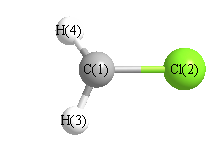Jump to
S1C2
Energy calculated at CCSD=FULL/6-31G(2df,p)
| | hartrees |
|---|
| Energy at 0K | -498.842329 |
| Energy at 298.15K | |
| HF Energy | -498.471858 |
| Nuclear repulsion energy | 45.440252 |
The energy at 298.15K was derived from the energy at 0K
and an integrated heat capacity that used the calculated vibrational frequencies.
Vibrational Frequencies calculated at CCSD=FULL/6-31G(2df,p)
| Mode Number |
Symmetry |
Frequency
(cm-1) |
Scaled Frequency
(cm-1) |
IR Intensities
(km mol-1) |
Raman Act
(Å4/u) |
Dep P |
Dep U |
|---|
| 1 |
A' |
3241 |
3051 |
5.13 |
|
|
|
| 2 |
A' |
1443 |
1359 |
12.60 |
|
|
|
| 3 |
A' |
868 |
818 |
31.39 |
|
|
|
| 4 |
A' |
250 |
236 |
60.29 |
|
|
|
| 5 |
A" |
3390 |
3192 |
0.16 |
|
|
|
| 6 |
A" |
1018 |
958 |
0.02 |
|
|
|
Unscaled Zero Point Vibrational Energy (zpe) 5105.0 cm
-1
Scaled (by 0.9416) Zero Point Vibrational Energy (zpe) 4806.9 cm
-1
See section
III.C.1 List or set vibrational scaling factors
to change the scale factors used here.
See section
III.C.2
Calculate a vibrational scaling factor for a given set of molecules
to determine the least squares best scaling factor.
Geometric Data calculated at CCSD=FULL/6-31G(2df,p)
Point Group is Cs
Cartesians (Å)
| Atom |
x (Å) |
y (Å) |
z (Å) |
|---|
| C1 |
-0.009 |
1.116 |
0.000 |
| Cl2 |
-0.009 |
-0.584 |
0.000 |
| H3 |
0.100 |
1.614 |
0.948 |
| H4 |
0.100 |
1.614 |
-0.948 |
Atom - Atom Distances (Å)
| |
C1 |
Cl2 |
H3 |
H4 |
| C1 | | 1.7001 | 1.0759 | 1.0759 |
Cl2 | 1.7001 | | 2.3959 | 2.3959 | H3 | 1.0759 | 2.3959 | | 1.8952 | H4 | 1.0759 | 2.3959 | 1.8952 | |
 More geometry information
More geometry information
Calculated Bond Angles
| atom1 |
atom2 |
atom3 |
angle |
|
atom1 |
atom2 |
atom3 |
angle |
| Br2 |
C1 |
H3 |
117.562 |
|
Br2 |
C1 |
H4 |
117.562 |
| H3 |
C1 |
H4 |
123.460 |
|
Electronic energy levels
Charges, Dipole, Quadrupole and Polarizability
Jump to
S1C1
Energy calculated at CCSD=FULL/6-31G(2df,p)
| | hartrees |
|---|
| Energy at 0K | -498.842309 |
| Energy at 298.15K | |
| HF Energy | -498.471704 |
| Nuclear repulsion energy | 45.477528 |
The energy at 298.15K was derived from the energy at 0K
and an integrated heat capacity that used the calculated vibrational frequencies.
Vibrational Frequencies calculated at CCSD=FULL/6-31G(2df,p)
| Mode Number |
Symmetry |
Frequency
(cm-1) |
Scaled Frequency
(cm-1) |
IR Intensities
(km mol-1) |
Raman Act
(Å4/u) |
Dep P |
Dep U |
|---|
| 1 |
A1 |
3245 |
3055 |
4.33 |
|
|
|
| 2 |
A1 |
1443 |
1359 |
12.80 |
|
|
|
| 3 |
A1 |
872 |
821 |
30.34 |
|
|
|
| 4 |
B1 |
174i |
164i |
66.03 |
|
|
|
| 5 |
B2 |
3396 |
3198 |
0.33 |
|
|
|
| 6 |
B2 |
1014 |
955 |
0.02 |
|
|
|
Unscaled Zero Point Vibrational Energy (zpe) 4897.9 cm
-1
Scaled (by 0.9416) Zero Point Vibrational Energy (zpe) 4611.8 cm
-1
See section
III.C.1 List or set vibrational scaling factors
to change the scale factors used here.
See section
III.C.2
Calculate a vibrational scaling factor for a given set of molecules
to determine the least squares best scaling factor.
Geometric Data calculated at CCSD=FULL/6-31G(2df,p)
Point Group is C2v
Cartesians (Å)
| Atom |
x (Å) |
y (Å) |
z (Å) |
|---|
| C1 |
0.000 |
0.000 |
-1.114 |
| Cl2 |
0.000 |
0.000 |
0.584 |
| H3 |
0.000 |
0.950 |
-1.619 |
| H4 |
0.000 |
-0.950 |
-1.619 |
Atom - Atom Distances (Å)
| |
C1 |
Cl2 |
H3 |
H4 |
| C1 | | 1.6978 | 1.0755 | 1.0755 |
Cl2 | 1.6978 | | 2.3983 | 2.3983 | H3 | 1.0755 | 2.3983 | | 1.8996 | H4 | 1.0755 | 2.3983 | 1.8996 | |
 More geometry information
More geometry information
Calculated Bond Angles
| atom1 |
atom2 |
atom3 |
angle |
|
atom1 |
atom2 |
atom3 |
angle |
| Br2 |
C1 |
H3 |
117.974 |
|
Br2 |
C1 |
H4 |
117.974 |
| H3 |
C1 |
H4 |
124.053 |
|
Electronic energy levels
Charges, Dipole, Quadrupole and Polarizability
